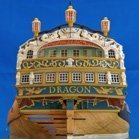-
Posts
9,155 -
Joined
-
Last visited
Reputation Activity
-
 Jim Lad got a reaction from FriedClams in Herzogin Cecilie 1902 by Jim Lad - Four Masted Barque
Jim Lad got a reaction from FriedClams in Herzogin Cecilie 1902 by Jim Lad - Four Masted Barque
A little more progress on the 'Duchess'.
All six yards are now crossed on the mainmast, so that leaves only six more square sails to rig. When I look at the model now, I sometimes think that she's getting towards completion; then I remember ratlines, braces, staysail sheets and deck details to complete and go back to wondering whether she'll ever get there! 😉
John
-
 Jim Lad got a reaction from MAGIC's Craig in Herzogin Cecilie 1902 by Jim Lad - Four Masted Barque
Jim Lad got a reaction from MAGIC's Craig in Herzogin Cecilie 1902 by Jim Lad - Four Masted Barque
A little more progress on the 'Duchess'.
All six yards are now crossed on the mainmast, so that leaves only six more square sails to rig. When I look at the model now, I sometimes think that she's getting towards completion; then I remember ratlines, braces, staysail sheets and deck details to complete and go back to wondering whether she'll ever get there! 😉
John
-
 Jim Lad got a reaction from Javelin in Herzogin Cecilie 1902 by Jim Lad - Four Masted Barque
Jim Lad got a reaction from Javelin in Herzogin Cecilie 1902 by Jim Lad - Four Masted Barque
A little more progress on the 'Duchess'.
All six yards are now crossed on the mainmast, so that leaves only six more square sails to rig. When I look at the model now, I sometimes think that she's getting towards completion; then I remember ratlines, braces, staysail sheets and deck details to complete and go back to wondering whether she'll ever get there! 😉
John
-
 Jim Lad got a reaction from ccoyle in Herzogin Cecilie 1902 by Jim Lad - Four Masted Barque
Jim Lad got a reaction from ccoyle in Herzogin Cecilie 1902 by Jim Lad - Four Masted Barque
A little more progress on the 'Duchess'.
All six yards are now crossed on the mainmast, so that leaves only six more square sails to rig. When I look at the model now, I sometimes think that she's getting towards completion; then I remember ratlines, braces, staysail sheets and deck details to complete and go back to wondering whether she'll ever get there! 😉
John
-
 Jim Lad got a reaction from davyboy in Herzogin Cecilie 1902 by Jim Lad - Four Masted Barque
Jim Lad got a reaction from davyboy in Herzogin Cecilie 1902 by Jim Lad - Four Masted Barque
A little more progress on the 'Duchess'.
All six yards are now crossed on the mainmast, so that leaves only six more square sails to rig. When I look at the model now, I sometimes think that she's getting towards completion; then I remember ratlines, braces, staysail sheets and deck details to complete and go back to wondering whether she'll ever get there! 😉
John
-
 Jim Lad got a reaction from Siggi52 in Herzogin Cecilie 1902 by Jim Lad - Four Masted Barque
Jim Lad got a reaction from Siggi52 in Herzogin Cecilie 1902 by Jim Lad - Four Masted Barque
A little more progress on the 'Duchess'.
All six yards are now crossed on the mainmast, so that leaves only six more square sails to rig. When I look at the model now, I sometimes think that she's getting towards completion; then I remember ratlines, braces, staysail sheets and deck details to complete and go back to wondering whether she'll ever get there! 😉
John
-
 Jim Lad got a reaction from FriedClams in Lancha Chilota by JacquesCousteau – Scale 1:32 – Chilean Coasting Sloop
Jim Lad got a reaction from FriedClams in Lancha Chilota by JacquesCousteau – Scale 1:32 – Chilean Coasting Sloop
Very realistic work on that bottle.
John
-
 Jim Lad got a reaction from JacquesCousteau in Lancha Chilota by JacquesCousteau – Scale 1:32 – Chilean Coasting Sloop
Jim Lad got a reaction from JacquesCousteau in Lancha Chilota by JacquesCousteau – Scale 1:32 – Chilean Coasting Sloop
Very realistic work on that bottle.
John
-
 Jim Lad got a reaction from Glen McGuire in Lancha Chilota by JacquesCousteau – Scale 1:32 – Chilean Coasting Sloop
Jim Lad got a reaction from Glen McGuire in Lancha Chilota by JacquesCousteau – Scale 1:32 – Chilean Coasting Sloop
Very realistic work on that bottle.
John
-
 Jim Lad got a reaction from Mirabell61 in Sternwheeler From the Susquehanna River's Hard Coal Navy by Keith Black - 1:120 Scale
Jim Lad got a reaction from Mirabell61 in Sternwheeler From the Susquehanna River's Hard Coal Navy by Keith Black - 1:120 Scale
A very different looking paddle wheeler, Keith. She looks like she's had a hard life.
John
-
 Jim Lad got a reaction from Nirvana in Greetings from the UK
Jim Lad got a reaction from Nirvana in Greetings from the UK
Hello Mashuno, and a warm welcome to the forum from 'Down Under'.
John
-
 Jim Lad got a reaction from shipman in Loreley 1884 by Ilhan Gokcay - 1/75 - Scale Steam Yacht
Jim Lad got a reaction from shipman in Loreley 1884 by Ilhan Gokcay - 1/75 - Scale Steam Yacht
A first class pictorial tutorial on your method of making vacuum formed boats, Ilhan. Thanks for that!
John
-
 Jim Lad got a reaction from Ilhan Gokcay in Loreley 1884 by Ilhan Gokcay - 1/75 - Scale Steam Yacht
Jim Lad got a reaction from Ilhan Gokcay in Loreley 1884 by Ilhan Gokcay - 1/75 - Scale Steam Yacht
A first class pictorial tutorial on your method of making vacuum formed boats, Ilhan. Thanks for that!
John
-
 Jim Lad got a reaction from Canute in SS Klondike II by John Ruy - 1/8” = 1’ (1/96 scale) - Sternwheeler Riverboat
Jim Lad got a reaction from Canute in SS Klondike II by John Ruy - 1/8” = 1’ (1/96 scale) - Sternwheeler Riverboat
Nice progress, John!
John
-
 Jim Lad got a reaction from FriedClams in SS Klondike II by John Ruy - 1/8” = 1’ (1/96 scale) - Sternwheeler Riverboat
Jim Lad got a reaction from FriedClams in SS Klondike II by John Ruy - 1/8” = 1’ (1/96 scale) - Sternwheeler Riverboat
I agree with the above comments - now for the fun bit!
John
-
 Jim Lad got a reaction from FriedClams in USS Cape (MSI-2) by Dr PR - 1:48 - Inshore Minesweeper
Jim Lad got a reaction from FriedClams in USS Cape (MSI-2) by Dr PR - 1:48 - Inshore Minesweeper
Just catching up, Phil. She's coming along very nicely.
John
-
 Jim Lad got a reaction from Paul Le Wol in USS Cape (MSI-2) by Dr PR - 1:48 - Inshore Minesweeper
Jim Lad got a reaction from Paul Le Wol in USS Cape (MSI-2) by Dr PR - 1:48 - Inshore Minesweeper
Just catching up, Phil. She's coming along very nicely.
John
-
 Jim Lad got a reaction from westwood in HMS Portland 1770 by westwood - Portland Scale Ship Co. - 1:48 - 50 gun 4th rate
Jim Lad got a reaction from westwood in HMS Portland 1770 by westwood - Portland Scale Ship Co. - 1:48 - 50 gun 4th rate
Just found your log. This looks a very interesting build.
John
-
 Jim Lad got a reaction from John Ruy in SS Klondike II by John Ruy - 1/8” = 1’ (1/96 scale) - Sternwheeler Riverboat
Jim Lad got a reaction from John Ruy in SS Klondike II by John Ruy - 1/8” = 1’ (1/96 scale) - Sternwheeler Riverboat
Nice progress, John!
John
-
 Jim Lad reacted to Siggi52 in The Gokstad Ship 900 AD by Siggi52 - 1:50
Jim Lad reacted to Siggi52 in The Gokstad Ship 900 AD by Siggi52 - 1:50
Hello, and thank you for your comments and likes
today I started with an experiment to create the shroud pins. With some branches from my boxtree. Let's see what's going to be.
The arrow shows one of the Gokstad ship in the scale, it is 13mm long!
-
 Jim Lad got a reaction from Paul Le Wol in SS Klondike II by John Ruy - 1/8” = 1’ (1/96 scale) - Sternwheeler Riverboat
Jim Lad got a reaction from Paul Le Wol in SS Klondike II by John Ruy - 1/8” = 1’ (1/96 scale) - Sternwheeler Riverboat
Nice progress, John!
John
-
 Jim Lad got a reaction from FriedClams in Steam Schooner Wapama 1915 by Paul Le Wol - Scale 1/72 = From Plans Drawn By Don Birkholtz Sr.
Jim Lad got a reaction from FriedClams in Steam Schooner Wapama 1915 by Paul Le Wol - Scale 1/72 = From Plans Drawn By Don Birkholtz Sr.
Delightful progress, Paul.
John
-
 Jim Lad got a reaction from Knocklouder in SS Klondike II by John Ruy - 1/8” = 1’ (1/96 scale) - Sternwheeler Riverboat
Jim Lad got a reaction from Knocklouder in SS Klondike II by John Ruy - 1/8” = 1’ (1/96 scale) - Sternwheeler Riverboat
Nice progress, John!
John
-
 Jim Lad got a reaction from Siggi52 in The Gokstad Ship 900 AD by Siggi52 - 1:50
Jim Lad got a reaction from Siggi52 in The Gokstad Ship 900 AD by Siggi52 - 1:50
I agree with Ian! 🙂
John
-
 Jim Lad got a reaction from Keith Black in SS Klondike II by John Ruy - 1/8” = 1’ (1/96 scale) - Sternwheeler Riverboat
Jim Lad got a reaction from Keith Black in SS Klondike II by John Ruy - 1/8” = 1’ (1/96 scale) - Sternwheeler Riverboat
Nice progress, John!
John















